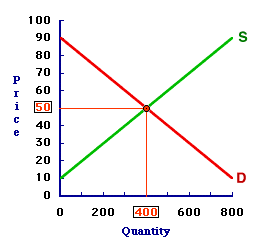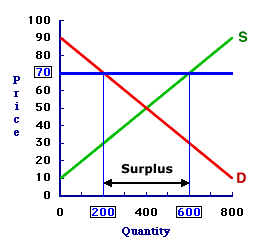
|
|
FAVORABLE BALANCE OF PAYMENTS: An imbalance in a nation's balance of payments in which payments made by the country are less than payments received by the country. This is also termed a balance of payments surplus. It's considered favorable because more currency is flowing into the country than is flowing out. Such an unequal flow of currency will expand the supply of money in the nation and subsequently cause a decrease in the exchange rate relative to the currencies of other nations. This then has implications for inflation, unemployment, production, and other facets of the domestic economy. A balance of trade surplus is often the source of a balance of payments surplus, but other payments can turn a balance of trade surplus into a balance of payments deficit.
Visit the GLOSS*arama
|
|


|

|
                           PRICE FLOOR: A legally established minimum price that is imposed on a market ABOVE the price that otherwise would be achieved in equilibrium. A price floor is placed on a market with the goal of keeping the price high, presumably based on the notion that the equilibrium price is too low. If imposed on a competitive market free of market failures, a price floor creates a surplus, or excess supply. A price floor places a downward limit on the price of good. Buyers and sellers can exchange the good at prices more than the floor, but not less. The primary goal of a price floor is to keep the price of a good high and thus generate more revenue to the sellers.Price floors are most often placed on markets for goods that policy makers deem are an important source of income for the sellers and that the existing price is too low to maintain a suitable level of income, perhaps due to market control among the demanders. Examples of markets that have been subject to price floors are agricultural goods and labor. How It Works| Price Floor |  |
As luck would have it, the Shady Valley City Council has decided to impose a price floor on the market for 8-track tapes. The current equilibrium condition for this market is illustrated in the graph presented to the right. Without the price floor buyers and sellers trade 400 tapes at a price of 50 cents each. For some unknown reason, the Shady Valley City Council feels that 50 cents is simply too little to receive for 8-track tapes. Hence they have decided to impose a price floor of 70 cents on this market.To highlight this price floor, click the [Price Floor] button. The line drawn across the graph at the 70 cent price indicates this minimum price. With the price floor, the Shady Valley City County outlaws any and all exchanges at prices less than 70 cents. What is the market to do? - Demand Side: The buyers are willing and able to purchase 200 tapes at this 70 cent price, which can be revealed by clicking the [Demand] button. At this price, demanders can obtain 70 cents worth of satisfaction from 200 tapes. They are unwilling and unable to buy more.
- Supply Side: The sellers, however, are willing and able to offer up to 600 tapes for sale at the 70 cent price, which can be highlighted by clicking the [Supply] button. At 70 cents, suppliers can cover the production cost of 600 tapes.
- Surplus: The combination of the quantity demanded and the quantity supplied means that the market has a surplus of 400 tapes. The sellers want to sell 400 tapes more than the buyers want to buy. This surplus can be highlighted by clicking the [Surplus] button.
Good for Some, Bad for OthersThe usual objective of a price floor is to generate an adequate amount of revenue for the sellers. A 70 cent price floor on the market for 8-track tapes certainly accomplishes this goal. Those who sell 8-track tapes at 70 cents each receive more revenue than at 50 cents. They receive an extra 20 cents on each tape sold. Good for them.There is, however, a bit of bad with this price floor. Prior to the price floor, 400 tapes are exchanged in the market. With the price floor, only 200 tapes are exchanged. Fewer tapes are exchanged. Moreover, given the high 70 cent price, sellers are actually willing to sell 600 tapes, 400 tapes more than purchased. While those who are able to sell the tapes do so at a higher price, a great many sellers sell less or none at all and thus receive less revenue or none at all. Bad for them. Although this particular market for 8-track tapes generates a substantial surplus at the 70 cent price, the actual surplus that might arise in other markets depends on the specific characteristics of the market. From a sheer graphical standpoint, the surplus is less if the demand and supply curves are more steeply sloped or more inelastic. In other words, if the demand and supply are relatively inelastic, then the goal of generating revenue to sellers, without excluding a lot of sellers from the market, is more easily achieved. Illegal ExchangeLike any law, a legally mandated price floor can be violated. Some buyers and sellers are inclined to undertake illegal exchanges at prices below the legal maximum.| Illegal Trades |  |
Why would buyers and sellers risk punishment to engage in illegal trades?The price floor in the market for 8-track tapes displayed at the right means that 200 tapes are legally sold for 70 cents each. This creates the surplus, or excess supply, of 400 tapes. In a market with an unregulated surplus, sellers are inclined to bid down the price. While they are not legally allowed to do so with a price floor, the motivation still exists. In fact, the motivation might be so powerful that sellers are willing to engage in illegal trades. On the other side of the exchange, buyers are always inclined to pay less than the maximum demand price for a good. If the sellers charge less than 70 cents, then buyers are willing to listen. The price, however, must be low enough to compensate the buyers for the risk of punishment. If the risk is slight, the price need not be much lower than 70 cents. If the risk is greater, then the price must be lowered even more.

Recommended Citation:PRICE FLOOR, AmosWEB Encyclonomic WEB*pedia, http://www.AmosWEB.com, AmosWEB LLC, 2000-2025. [Accessed: July 18, 2025].
Check Out These Related Terms... | | | | | |
Or For A Little Background... | | | | | | | | | |
And For Further Study... | | | | | |
Search Again?
Back to the WEB*pedia
|



|

|
YELLOW CHIPPEROON
[What's This?]
Today, you are likely to spend a great deal of time searching the newspaper want ads trying to buy either a T-shirt commemorating the 2000 Olympics or a genuine fake plastic Tiffany lamp. Be on the lookout for telephone calls from former employers.
Your Complete Scope
This isn't me! What am I?
|

|
|
The first paper notes printed in the United States were in denominations of 1 cent, 5 cents, 25 cents, and 50 cents.
|

|
|
"A winner is someone who recognizes his God-given talents, works his tail off to develop them into skills, and uses those skills to accomplish his goals. " -- Larry Bird, basketball player
|

|
AOQ
Average Outgoing Quality
|

|
|
Tell us what you think about AmosWEB. Like what you see? Have suggestions for improvements? Let us know. Click the User Feedback link.
User Feedback
|


|


